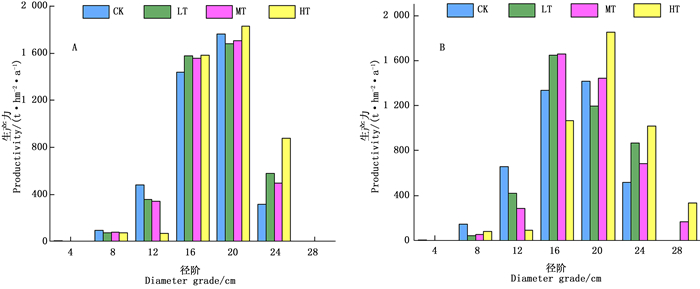-
华北落叶松(Larix principis-rupprechtii Mayr)是我国重要的造林树种[1], 但在造林过程中面临着造林密度过高、成材率低、生产力下降、人工林地力衰退等问题[2-3]。因此, 有必要通过合理的营林措施调整林分密度促进林木生长并提高人工林生产力[4]。抚育间伐可通过改善林冠层空间和减少树木间的竞争对林内资源进行再分配, 促进林木单株生长, 提升林木单株生产力[5]。但针对于间伐能否提高林分生产力这一问题,前人研究结果并不一致,Marshall和Curtis等认为林分生产力随间伐强度的增加而减少[6],但Pitt和Lanteigne等人通过研究香脂冷杉林(Abies balsamea Mill)发现间伐后的林分生产力高于未间伐的林分[7]。因此研究间伐能否提高华北落叶松人工林生产力并确定最适间伐强度对进一步发展森林可持续性经营有指导意义。
近年来,已有大量关于抚育间伐对林木生长的研究, 多数集中探讨间伐对各林木生长指标的影响及不同间伐强度下林分各径级株数分布[5, 8],但涉及土壤因子对林木各生长指标及林分生产力影响的研究较少,且绝大多数研究存在研究周期短、缺乏间伐后连年时间对比的问题[4, 8-9]。为此, 本研究选取4种不同间伐强度的华北落叶松人工林为研究对象, 分别通过间伐后第2年与间伐后第4年两个时间点研究不同间伐强度对林分生长状况的影响及其与土壤因子的关系,并找出影响华北落叶松人工林生长的关键土壤因子, 提出适合华北落叶松人工林生长的林分密度, 为加速林木生长、增强林分生产力、维持森林生态系统固有功能、实现华北落叶松林可持续的高效经营提供依据。
HTML
-
研究区位于山西省长治市沁源县好地方林场(111°59′~122°01′ E, 36°44′~36°47′ N), 属暖温带半干旱大陆性季风气候, 春秋季相对较短, 降水多集中在夏季。年平均降水量650~700 mm, 年平均气温6.3℃, 1月平均温最低为-11.0℃, 7月平均气温最高为14.2℃。土壤以棕土和褐土为主。海拔高度在1 749~2 431 m之间。森林植被类型为华北落叶松(Larix principis-rupprechtii Mayr)人工林。林下灌木主要有土庄绣线菊(Spiraea pubescens Turcz)、黄刺玫(Rosa xanthine Lindl)、忍冬(Lonicera altamanni Thunb)等, 林下草本主要有细叶苔草(Carex rigescens)、蛇莓(Duchesnea indica Focke)、小红菊(Dendranthema chanetii)等[1, 10, 13]。
-
本研究选用的华北落叶松人工林种植于1981年, 苗木全部选自于长势良好, 苗高在25 cm以上, 地径在0.6 cm以上的2年生一级苗。2007年对研究地进行第一次打枝、疏伐、集材归楞等抚林措施。2012年4月进行第2次人工抚育后,选择12块25 m×25 m规格的固定样地,对其进行不同间伐强度处理, 共设置4种不同处理, 每种处理3个重复, 基本情况见表 1。
处理
Treatment采伐强度
Intensity/%平均胸径
DBH/cm平均高度
Height/m平均密度
Density/(trees·hm-2)坡度
Slope/°坡向
Slope aspect坡位
Slope positionCK 0 14.61 13.80 2 032 27 北 上坡 LT 15 14.57 13.78 1 712 25 北 上坡 MT 35 15.03 14.00 1 376 23 北 上坡 HT 50 14.98 13.92 895 22 北 上坡 注:CK:未采伐no thinning;LT:轻度采伐light thinning;MT:中度采伐medium thinning;HT:重度采伐heavy thinning Table 1. Characteristics of Larix principis-rupprechtii plantation in the survey plot
-
本研究分别于间伐后第2年(2014)和第4年(2016)对样地内的乔木(DBH>2 cm)进行每木检尺, 记录不同间伐强度下树木胸径、树高、活枝下高、冠幅、高径比和冠径比。
-
于2014年和2016年华北落叶松人工林生长季阶段(4月、6月、8月、10月),运用5点采样法在每块样地内0~20 cm土层取样,每个样地土样进行混合放入自封袋中用于土壤化学性质的测定。同时,在每块样地边界选取具有代表性的位点挖3个20 cm深的土壤剖面, 用环刀取样后放入铝盒用于土壤物理性质的测定。
-
2018年8月对样地内乔木(DBH≥2 cm)进行每木检尺, 乔木胸径以4 cm为一个径阶, 将每个样地内乔木整合, 每个径阶选取1~2株标准木用生长锥在胸高处分别沿山坡等高线和垂直山坡等高线两个方向钻取两个树芯(钻至树木髓心处),并固定在合适的直径木质凹槽中。
-
采用环刀法测定土壤密度与含水率[10];采用悬浊液pH计法测定土壤pH;高温外加热重铬酸钾氧化—容量法测定土壤有机碳;土壤全氮与全磷分别采用浓H2SO4-混合加速剂消化法与H2SO4-HClO4消化法通过AA3-连续流动分析仪进行测定。
-
林木高径比为样地内树木树高与胸径的比值,林木冠径比为样地内树木树冠直径与胸径的比值[11]。
-
年轮条通过Lintab树木年轮分析仪测量年轮宽度后,采用分级标准木法以及异速生长模型计算历年乔木层生物量[12-13], 相邻年份样地乔木层生物量之差即为样地乔木层生产力, 乔木层生物量与生产力计算公式如下[14-15]
式中:Y为标准木乔木层生物量;a为林龄;DBH为标准木胸径;i为径阶;W为乔木层生物量;n为株数;NPP为地上净生产力。
-
使用Microsoft Office Excel 2018对数据进行初步整理;采用SPSS25.0软件对不同间伐时间下各间伐强度的林分生长因子进行单因素方差分析和LSD多重比较, 检验树木生长与间伐强度的显著性, 其中显著水平设为α=0.05;对林木生长与土壤物理化学性质等指标采用Pearson相关性分析进行研究, 分析树木生长与土壤因子的相关性;用OriginPro2018软件作不同间伐强度林分平均乔木层生物量、生产力和胸径分布图。
2.1. 样地选择与设置
2.2. 样地调查及取样
2.2.1. 样地调查
2.2.2. 土壤取样
2.2.3. 标准木年轮条取样
2.3. 土壤物理化学性质指标测定
2.4. 林木生长指标与生产力计算
2.4.1. 林木高径比、冠径比计算
2.4.2. 乔木层生物量与生产力计算
2.5. 数据分析
-
由单因素方差分析及LSD多重比较得出, 林木各生长因子因不同间伐强度与间伐时间而差异显著(表 2), 其中, 间伐后第2年, MT与HT单株胸径显著大于CK, 分别比CK增加了1.09和1.55 cm, LT林木单株胸径小于CK但差异不显著;各间伐强度下林木树高与枝下高表现相同, 皆为MT最大;林木单株冠幅随间伐强度增加而增大, 分别比CK增加了0.35、0.39、0.67 m;林木高径比与冠径比分别维持在0.930.97与0.180.20之间;间伐后第4年, 林木单株胸径随间伐强度的增加而增大且各样地差异性显著, 其中MT、HT较CK分别增加了1.33和2.16 cm;林木树高表现为:MT>HT>LT>CK,间伐后第4年枝下高与冠幅生长状况与间伐后第2年相同,其中,随间伐强度增强,林分平均冠幅较CK分别增加0.36、0.64、0.93 m;MT、HT样地中林分平均枝下高较CK分别增加了1.23和1.06 m;LT与CK样地内林木枝下高由第2年显著性差异变为非显著性差异;LT与MT样地内林木平均冠幅由非显著性差异变为显著性差异。间伐后第4年高径比与林木冠径比分别处于0.91~0.98与0.19~0.22之间,其中各间伐强度下林木冠径比皆大于CK且差异显著。
伐后时间
Time间伐强度
Intensity平均胸径
DBH/cm平均树高
Height/m平均枝下高
Branch height/m平均冠幅
Canopy width/m高径比
Ratio of height to diameter冠径比
Crown diameter ratio间伐后第2年
The 2nd year after thinningCK 14.97±0.51c 14.13±2.30c 7.13±0.16b 2.53±0.04c 0.97±0.06a 0.18±0.003b LT 14.95±0.69c 14.06±2.02c 6.53±0.09c 2.88±0.05b 0.95±0.01c 0.20±0.004a MT 16.06±0.37b 15.78±0.96a 8.66±0.19a 2.92±0.05b 0.97±0.03a 0.19±0.004ab HT 16.52±1.23a 15.45±2.22b 8.46±0.38a 3.20±0.06a 0.93±0.01c 0.20±0.004a 间伐后第4年
The 4th year after thinningCK 15.11±0.25d 14.59±0.12c 7.59±0.14b 2.85±0.07d 0.98±0.02a 0.19±0.009c LT 15.21±0.20c 14.65±0.10c 7.43±0.21b 3.21±0.05c 0.96±0.01b 0.21±0.005a MT 16.44±0.24b 16.17±0.97a 8.82±0.27a 3.49±0.07b 0.96±0.03b 0.21±0.003a HT 17.27±0.23a 15.88±0.49b 8.65±0.31a 3.78±0.06a 0.91±0.01c 0.22±0.003a Table 2. Growth status of Larix principis-rupprechtii plantations with different thinning intensities
间伐后2年至4年中, 林分各个指标有不同程度的增长(表 3)。其中平均胸径增长幅度随间伐强度增强而增大, 树高增长量与枝下高增长量在各间伐强度样地中表现一致, 均表现为LT>CK>HT>MT, 冠幅平均增长量表现为HT>MT>LT>CK。总体上看, 不同间伐时期各间伐强度样地中径阶为16 cm株数最多, 其次是径阶为12 cm与径阶为20 cm的华北落叶松, 再次是径阶为8 cm与24 cm的华北落叶松, 径阶为4 cm与28 cm的林木株数所占比重最小(图 1)。间伐4年后, 径阶为8 cm与径阶为12 cm的株数减少, 径阶为20 cm的株数增加, 各样地径阶为24 cm的株数也有增加但增幅不大(图 1);2年间, 在各个间伐强度样地中, CK株数变化在径阶为16 cm中最明显, 由间伐第2年的60株变为间伐第4年后的46株。
间伐强度
Intensity胸径
DBH/cm树高
Height/m枝下高
Branch height /m冠幅
Canopy width/mCK 0.14 0.46 0.46 0.32 LT 0.26 0.59 0.90 0.33 MT 0.38 0.39 0.16 0.57 HT 0.75 0.43 0.19 0.58 Table 3. Growth of single-plant indicators in the second and fourth years after thinning
-
对4种不同间伐强度下华北落叶松人工林平均乔木层生物量和生产力的分析可知, 在间伐后第2年以及间伐后第4年, 各乔木层生物量均随着间伐强度增大而减少, 而平均乔木层生产力随间伐强度增大而增加。不同间伐强度华北落叶松人工林在间伐后第2年时平均乔木层生产力全部大于各自在间伐后第4年时的生产力(表 4)。各间伐强度下华北落叶松人工林乔木层生产力主要集中在径阶为16 cm与径阶为20 cm林木中;在径阶为24 cm的林木中, 各间伐强度华北落叶松人工林在间伐后第4年的生产力相比于间伐后第二年均有所上升;各间伐强度下径阶为8 cm与28 cm的林木其乔木层生产力最少(图 2)。
伐后时间
Time间伐强度
Intensity平均乔木层生物量
Biomass/(t·hm-2)平均乔木层生产力
NPP/(t·hm-2·a-1)间伐后第2年
The 2nd year after thinningCK 205.09 4.10 LT 180.38 4.26 MT 171.77 4.35 HT 154.49 4.69 间伐后第4年
The 4nd year after thinningCK 218.06 4.07 LT 191.54 4.17 MT 178.49 4.29 HT 163.81 4.45 Table 4. Average biomass and productivity of arbor layer in different thinning intensity stands
-
相同年份内MC、SOC、TN间伐组均高于对照组, 其中间伐2年后, MC、SOC、TN间伐组比对照组分别增加了11.19%、10.92%与6.74%;间伐4年后, 间伐组MC、SOC、TN比对照组分别增加了22.07%、15.57%和13.99%;间伐组中TP含量高于其同年对照组含量但涨幅不明显;间伐后第4年与间伐后第2年相比, MC含量增加, 在间伐组与对照组中分别增加了6.88%与17.33%;pH、SOC、TN、TP含量减小, 其中在对照组中分别减少5.25%、51.06%、38.34%、40.54%, 在间伐组中分别减少了4.28%、44.98%、29.55%与27.91%(表 5)。参考全国第二次土壤普查养分分级标准, 在2年中, TN在对照组中由一级水平下降到二级水平,在间伐组仍保持在一级水平不变;TP在对照组中由四级下降到五级, 在间伐组维持在四级不变。
土壤因子 间伐后第2年2 years after thinning 间伐后第4年4 years after thinning 间伐分组 均值Mean 标准差SD 变异系数CV 均值Mean 标准差SD 变异系数CV SBD /(g·cm-3) 对照组 0.88 0.15 0.17 0.82 0.10 0.12 间伐组 0.88 0.11 0.13 0.83 0.12 0.14 MC/% 对照组 27.34 5.37 0.19 29.22 3.08 0.10 间伐组 30.40 5.02 0.16 35.67 5.16 0.14 pH 对照组 6.62 0.16 0.02 6.29 0.11 0.01 间伐组 6.58 0.30 0.04 6.31 0.15 0.02 SOC/(g·kg-1) 对照组 34.35 4.47 0.13 22.74 3.21 0.14 间伐组 38.10 5.43 0.14 26.28 3.65 0.14 TN/(g·kg-1) 对照组 2.67 0.28 0.11 1.93 0.37 0.19 间伐组 2.85 0.49 0.09 2.20 0.42 0.19 TP/(g·kg-1) 对照组 0.52 0.04 0.09 0.37 0.03 0.08 间伐组 0.55 0.05 0.09 0.43 0.04 0.09 注:表中SBD、MC、pH、SOC、TN、TP分别表示土壤密度、土壤含水率、土壤PH值、土壤有机碳、土壤全氮、土壤全磷。
Note: SBD, MC, PH, SOC, TN, and TP in the table indicate soil bulk density, soil moisture content, soil pH, soil organic carbon, soil total nitrogen, and soil total phosphorus, respectively.Table 5. Characteristics of soil physical and chemical properties of Larix principis-rupprechtii plantation in different thinning periods
-
相关性分析表明(表 6), 华北落叶松人工林平均胸径生长量与土壤有机碳、土壤全氮呈极显著正相关, 与土壤密度、土壤pH呈负相关;平均树高生长量与土壤全磷呈极显著正相关,与土壤全氮呈显著正相关,与土壤有机碳呈正相关但不显著;林木平均冠幅生长量与土壤全氮、全磷呈极显著正相关, 与土壤有机碳、土壤含水率呈显著正相关,土壤养分对树木生长有积极影响。
项目Items pH SBD MC SOC TN TP 胸径生长量DBH growth -0.314* -0.427* 0.202 0.723** 0.740** 0.231 树高生长量Tree height growth -0.145 -0.194 0.263 0.288 0.512* 0.626** 冠幅生长量Crown growth -0.173 -0.281 0.322* 0.583* 0.674** 0.785** 乔木层生物量Tree layer biomass -0.112 -0.082 0.181 -0.019 0.079 0.094 乔木层生产力Tree layer productivity 0.199 -0.04 0.042 0.115 -0.195 0.218 注:* P<0.05; ** P<0.01 Table 6. Correlation coefficient between growth characteristics and soil physical and chemical properties of Larix principis-rupprechtii plantation
3.1. 抚育间伐对树木生长特征的影响
3.2. 抚育间伐对乔木层和生产力的影响
3.3. 土壤物理化学因子特征
3.4. 华北落叶松人工林林木生长特性与土壤物理化学因子的关系
-
研究结果表明, 不同抚育间伐强度对林分生长特性产生不同影响, 总的来说, 随间伐强度的增加, 林木平均胸径与冠幅增大。由此得出, 间伐显著提升了林木生长特性, 这与Bardford等在针叶林中的研究结果一致[16]。其原因在于间伐后的林分对光照、水分等资源的竞争减少, 同时, 光照强度的增加提高了林分内温度, 导致凋落物的分解速率以及土壤有机碳分解速率加快, 提升林地土壤肥力, 林木通过进行充分的光合作用并吸收更多的资源使胸径以及冠幅增加[17]。然而, 本研究结果与Powers等人的研究结果中高强度间伐对树木生长有负面影响的结论不一致[18], 这可能因为Powers实验中所设置高强度间伐的林分密度为330株·hm-2, 是本实验所设置的高强度间伐林分密度(895株·hm-2)的2.71倍, 林分密度过低、间伐强度过高会破坏林分结构, 导致林分内水土流失严重, 除此之外, 过高间伐强度也会改变林分内风速使树木对风害的敏感性增加, 进而影响林木生物量的积累。通过间伐后2年与4年林木单株生长特性的比较发现, 间伐强度越大, 林分平均胸径定期生长量越大, 抚育间伐对平均胸径生长量有促进作用, 这与尤文忠等人研究结果不一致[8], 其认为轻度间伐和重度间伐的蒙古次生林中林分平均胸径增长量显著高于中度间伐林分平均胸径增长量。可能原因与林龄大小、树种组成、研究区气候等因素有关。
目前,对林木形质指标选定及等级划分没有统一标准,本研究通过引入胸径平均生长量、树高平均生长量、冠幅平均生长量、林木高径比和冠径比5个形质指标并参考尤健健[19]和陈晓阳[20]划分针叶树形质指标等级的标准,研究间伐强度对华北落叶松人工林林木形质的影响,结果表明重度间伐(50%)处理下除树高增长量和高径比以外其余指标均出现最大值且树高增长量也处于较高水平上(表 2、表 3), 说明林木形质质量在重度间伐下最高,抚育间伐能使林木保持良好干形。这与于世川等人[11]的研究结果一致,可能原因是林木通过抚育间伐存优去劣提升林分内总体形质质量,同时,间伐减少林木竞争,提升林内光照与温度,有利于林木生长。
-
本研究中, 林分乔木层生物量随抚育间伐强度增加而减小, 林分乔木层生产力随抚育间伐强度增加而增大, 且间伐后第2年生产力普遍小于间伐后第4年生产力, 这与前人研究结果一致[21-22]。这表明间伐通过改变林分密度调整林分结构, 改善林分内小气候并促进林木生长进而提高林分生产力。但Zeide等研究认为抚育间伐不能同时促进林分内单株林木生长与提升林分总生物量[23]。所以, 若想最大化林分生产力, 必须要权衡二者之间的关系。间伐后林内充足的光照及养分使单株林木发育状况改善, 林分乔木层生产力增大, 同时, 间伐减少了林分乔木层生物量进而减少林分蓄积量, 因此, 权衡间伐后林分内生物量减少量与生产力增加量之间的关系尤为重要。本实验中, LT与MT不仅没有可观的乔木层生产力, 但损耗了相对多的乔木层生物量;间伐后2年HT损耗生物量分别是LT、MT的2.05与1.52倍, 但增加的生产力分别是LT与MT的3.69、2.36倍。因此本研究中认为HT可以作为较好的间伐强度, 在保留乔木层生物量的同时有效提高了林分生产力, 因此间伐强度为50%(HT)是最适间伐强度, 为保留乔木层生物量的同时有效提高了林分生产力, 应将华北落叶松人工林林分密度控制在895株·hm-2附近。Gu等在研究不同间伐强度对落叶松人工林生长影响中发现落叶松人工林林分密度控制在850株·hm-2上下(间伐强度为40%)可有效提高林分生产力[24], 为间伐最适的强度,与本研究建议保留的林分最佳密度895株·hm-2一致。有鉴于此,在华北落叶松人工林的后续经营中,管理人员可根据研究区域的实际情况采取适宜的间伐强度,以促进当地华北落叶松人工林生产力提高。
-
本研究结果表明, 林木生长与土壤理化性质存在一定相关性。其中,土壤全氮与林木平均胸径生长量、平均树高生长量和平均冠幅生长量呈显著正相关;土壤全磷与林木平均树高生长量和平均冠幅生长量呈显著正相关,这与Paoli GD和Curran LM等研究结果一致[25],土壤全氮和土壤全磷对林木生长有重要的作用。同时,研究发现土壤密度与林木生长负相关,本研究结果与Wang等人一致,这是因为土壤密度是反映土壤内水分传导、气体渗透速率的重要指标,土壤密度越小的土壤其孔隙度越大,对林木根系的呼吸、水分的获取及土壤微生物的活动更有利[26]。除此之外,本研究发现土壤有机碳与林木平均胸径生长量与平均冠幅生长量呈显著正相关, 土壤有机碳促进林木生长,这与Luyssaert和Springteen等人研究结果一致,其认为土壤有机碳通过微生物分解转化为土壤养分,进而提升土壤肥力促进树木生长,同时,土壤有机碳含量在一定程度上反映有机质的含量,有机质是影响林木生长发育的关键土壤养分因子[27-28]。因此认为土壤有机碳对林木生长有重要影响。土壤各理化性质与林分生长指标关系复杂[29],Paoli GD研究发现, 土壤全钾、矿化氮、全氮影响婆罗洲南部森林的生长[25];Curtin D研究发现在哥伦比亚白云杉林中,土壤有效磷与硫含量同样影响林木生长[30]。出现影响林木生长土壤指标差异的原因可能与研究区的气候、不同树种以及不同土壤类型有关。在未来的研究中, 需进一步考虑气候因子与立地因子对华北落叶松人工林林木生长和生产力的影响, 综合土壤因子找到影响华北落叶松人工林生长和生产力的关键限制性因子, 为华北落叶松人工林的经营管理提供依据和数据支撑。
4.1. 抚育间伐对林木生长特性的影响
4.2. 抚育间伐对林分乔木层生物量及生产力的影响
4.3. 林木生长与土壤物理化学因子的关系
-
本研究通过研究不同抚育间伐强度下华北落叶松人工林生长状况、乔木层生物量与生产力的大小并结合样地内土壤物理与化学性质, 得出间伐可促进华北落叶松人工林单株林木胸径和冠幅生长, 减缓土壤有机碳及土壤养分的流失、增大林分生产力的结论, 并发现土壤有机碳(SOC)、土壤全氮(TN)土壤全磷(TP)是促进华北落叶松人工林林木生长的重要土壤因子;由抚育间伐综合效应得出重度间伐(50%,保留密度895株·hm-2)是提高华北落叶松生长生产力, 优化树木生长、保持树木良好干形的最佳间伐强度。

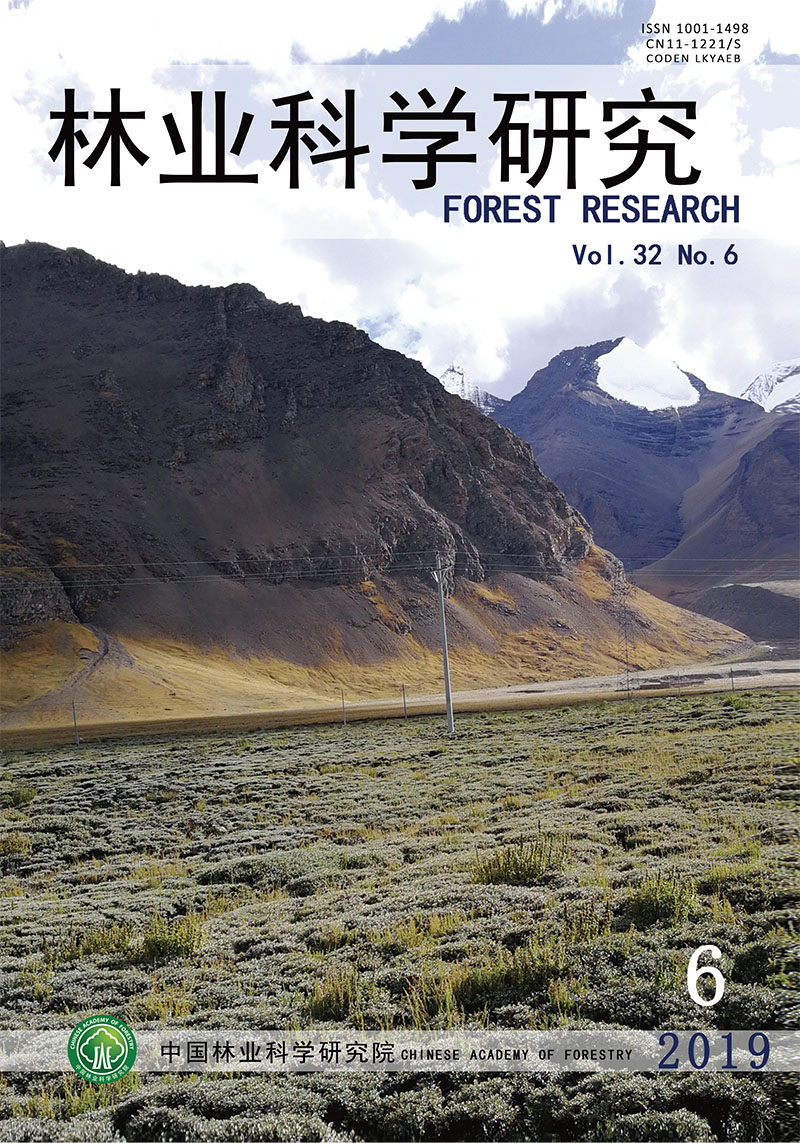


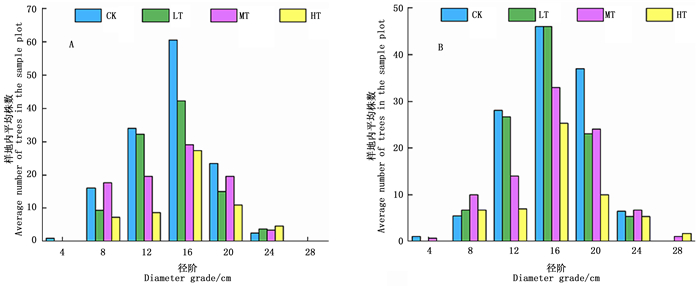

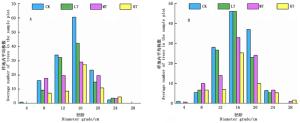
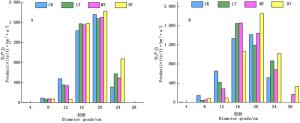
 DownLoad:
DownLoad:
